 This
is just the second generation of CLK, but its history can be traced
back
to 1968 when Mercedes launched its first generation CE coupe. The CE
coupe,
as well as its successors launched in 1976 and 1986, was derived from
Mercedes’
mid-size sedan equivalent to today’s E-class. From 1997, Stuttgart
decided
to base it on the smaller C-class platform, mainly for lower cost
rather
than technical reasons. This became the CLK. Oddly, Mercedes still
masked
it with headlamps resembling the E-class, pretending to be an E-class
coupe. This
is just the second generation of CLK, but its history can be traced
back
to 1968 when Mercedes launched its first generation CE coupe. The CE
coupe,
as well as its successors launched in 1976 and 1986, was derived from
Mercedes’
mid-size sedan equivalent to today’s E-class. From 1997, Stuttgart
decided
to base it on the smaller C-class platform, mainly for lower cost
rather
than technical reasons. This became the CLK. Oddly, Mercedes still
masked
it with headlamps resembling the E-class, pretending to be an E-class
coupe.
Now comes the new, second generation CLK. It is definitely a lot better than its predecessor - looks prettier, goes faster, rides & handles better... not just because of the usual evolution of technology, but Mercedes really committed a lot of development into the car and its chassis donor. The first thing catching my attention is its handsome styling. Now the CLK finally does not try to hide its bloodline. You can easily see its C-class root by the similar peanut-shape headlamps. If you dislike the quad headlights of E-class like me, this must be a good news to you. The design of new CLK reaches very high standard - sleek, elegant and simple, most people will easily love it. Its smoothness, instead of aggressiveness, reminds me the traditional style of Mercedes coupes, separating itself clearly from the muscle-full BMW coupes. Both attract me, but the CLK will definitely appeal more to female customers. Though base on C-class platform and share the same wheelbase, it has longer nose and tail to enable the coupe styling. Not a single piece of body panels is shared, including the steeper raked windscreen and rear window.
Thanks to the W202 donor platform, the new CLK is benefited with rack-and-pinion steering (instead of the old car’s inert recirculating ball design), a new 3-link front suspension and an aluminum-intensive rear multi-link suspension. Also, the chassis is 40% stronger in torsion than the old CLK, even though it gets rid of B-pillars! Discarding B-pillars improves a lot to the airy feel of cabin, especially when you wind down all the windows. The interior is also well designed, if not trimmed with the best materials. Mercedes could have used the decent dashboard from C-class, but for sense of uniqueness it gave the CLK a new dashboard with clean details and elegant circular air vents. Front seat comfort is always a strong card for Mercedes, so is this CLK. It also provides good rear passenger space, though both head and legroom are not as generous as Peugeot 406 Coupe. Performance and refinement You can feel the CLK is so well developed. Its chassis is so strong, suspensions are so absorbent, noise insulation is so good... so refined that sometimes you wonder why we buy coupes. Excitement is probably not the answer for most buyers, but good styling and self-presentation are. In this case, the Mercedes is fully successful. The CLK has look and image. Besides, it feels as refined and comfortable as other Mercedes sedans. All of its engines are smooth and most of them are extremely quiet. Even the new generation M-series supercharged four-cylinders are wonderfully smooth, just the supercharger becomes a bit vocal above mid-rev. The four-cylinders appears in CLK200 Kompressor (163hp) and CLK200 CGI (170hp), both are equipped with variable valve timing and twin-balancer shafts. CGI runs at direct injection. They are never fast cars, because the new CLK is 110kg heavier than its predecessor, but the supercharged engines are torquey enough for decent performance - expect a little over 9 seconds for 0-60mph.
Topping the CLK are two V8s - CLK500 is of course powered by the 306hp 5-litre V8. Pushing just 1585kg kerb weight you can see it can easily do 0-60mph in 5.7 seconds as claimed, even though this car shifts automatically. The performance flagship is CLK55 AMG, which runs a 367hp 5.5 V8 instead of the 354hp supercharged 3.2 V6 found in AMG version of C-class sedan and Sports Coupe. Technically, this might not be a clever decision, as the huge V8 burdens the nose of the small platform, but Mercedes believes that the all-important American market prefers a big-block V8. We shall leave the CLK55 to a separate report later. Now just concentrate on the CLK500. Excitement? The fast, smooth and effortless performance coupe scores nearly full marks in comfort side. What about handling? is it a double-edge sword like the mighty SL500? Unfortunately, the C-class platform has its limitation here. Without the help of active body control or air suspensions, the cheaper CLK fails to match the all-round ability of its more sophisticated sisters. To deliver excellent comfort, suspensions are deliberately tuned soft. Even in the Avantgarde version which has 5% stiffer springs, thicker anti-roll bars and 15mm lower ride height, the CLK still bias towards the soft side compare with BMW 3-series coupes, let alone M3. As a result, it understeers early on twisty roads, rolls too much at high g-force while feeling nose heavy. Although understeer and body roll set in progressively and predictably, they simply persuade you to back off. A similar story is found in steering. Although the new rack provides good communication, precision and adequate weighting, its 3.0 turns lock to lock is a bit slow for attacking twisty roads. In short, the CLK
is designed
for comfort and effortless performance rather than ultimate driving
excitement.
Anyway, this is already much better than its predecessor, which shone
in
neither comfort nor excitement. |
| The above report was last updated on 6 June 2002. All Rights Reserved. |
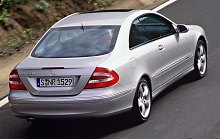 Compare
with another C-class coupe - the hatchback C-class Sports Coupe,
contrast
is even bigger. The Sports Coupe’s compact shape might look more
aggressive,
but it lacks the elegant style of the real coupe and feels definitely
cheaper.
In fact, Mercedes deliberately positions it lower than the CLK, as you
can see from its all-4-cylinder engine lineup. In contrast, the CLK has
a couple of V8s to choose from (5.0 and AMG 5.5), not even the C-class
sedan can compare with.
Compare
with another C-class coupe - the hatchback C-class Sports Coupe,
contrast
is even bigger. The Sports Coupe’s compact shape might look more
aggressive,
but it lacks the elegant style of the real coupe and feels definitely
cheaper.
In fact, Mercedes deliberately positions it lower than the CLK, as you
can see from its all-4-cylinder engine lineup. In contrast, the CLK has
a couple of V8s to choose from (5.0 and AMG 5.5), not even the C-class
sedan can compare with. 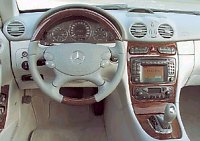 Then
come the familiar 170hp 2.6-litre and 224hp 3.2-litre V6 used in CLK240
and CLK320. We have talked about them too much (simply in every reports
of other Mercedes models), so I think not necessary to introduce again.
The same goes for the smoothie 5-speed automatic they mate with.
Then
come the familiar 170hp 2.6-litre and 224hp 3.2-litre V6 used in CLK240
and CLK320. We have talked about them too much (simply in every reports
of other Mercedes models), so I think not necessary to introduce again.
The same goes for the smoothie 5-speed automatic they mate with.
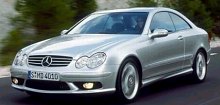 At
£50,000, this car is 25% more expensive than BMW M3. Does it
worth
that amount?
At
£50,000, this car is 25% more expensive than BMW M3. Does it
worth
that amount?
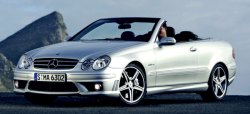 Unquestionably,
from CLK55 to CLK63 our focus is put on the new engine. This is the
first application of AMG's new 6.3-litre V8. It will power most of the
future AMG models, such as C63, E63, CLS63, SLK63, R63 and ML63,
replacing the existing 5.5-litre naturally aspirated and supercharged
V8s. Only the most expensive AMG models will be powered by another
engine - 6.0-litre twin-turbo V12. So you can see the importance of the
new 6.3 V8.
Unquestionably,
from CLK55 to CLK63 our focus is put on the new engine. This is the
first application of AMG's new 6.3-litre V8. It will power most of the
future AMG models, such as C63, E63, CLS63, SLK63, R63 and ML63,
replacing the existing 5.5-litre naturally aspirated and supercharged
V8s. Only the most expensive AMG models will be powered by another
engine - 6.0-litre twin-turbo V12. So you can see the importance of the
new 6.3 V8.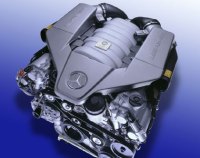 To squeeze 6208cc from the
engine, AMG replaced the usual cast-iron liners with TWAS
(twin-wire-arc-sprayed) coating to stretch the bore to maximum while
reducing friction between pistons and cylinder walls. In this way, the
V8 has a large 102.2 mm bore versus 94.2 mm stroke, perfect for a
high-revving engine. Compression ratio has been raised to 11.2:1 by
using more sophisticated engine management system to prevent from
engine knock. The connecting rods and crankshaft are forged items for
higher strength and lighter weight. The cylinder heads are fed by
racing-style, large and vertical intake and exhaust ducts to quicken
breathing. Torque delivery is enriched by a magnesium two-stage intake
manifolds, like the standard Mercedes V8. Finally, the crankcase
adopted a rigid bedplate design with closed-deck technology, cast-in
steel components to hold the crankshaft tight, just like that in the
Mercedes SLR McLaren
and BMW M5.
To squeeze 6208cc from the
engine, AMG replaced the usual cast-iron liners with TWAS
(twin-wire-arc-sprayed) coating to stretch the bore to maximum while
reducing friction between pistons and cylinder walls. In this way, the
V8 has a large 102.2 mm bore versus 94.2 mm stroke, perfect for a
high-revving engine. Compression ratio has been raised to 11.2:1 by
using more sophisticated engine management system to prevent from
engine knock. The connecting rods and crankshaft are forged items for
higher strength and lighter weight. The cylinder heads are fed by
racing-style, large and vertical intake and exhaust ducts to quicken
breathing. Torque delivery is enriched by a magnesium two-stage intake
manifolds, like the standard Mercedes V8. Finally, the crankcase
adopted a rigid bedplate design with closed-deck technology, cast-in
steel components to hold the crankshaft tight, just like that in the
Mercedes SLR McLaren
and BMW M5.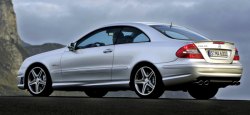 On the road, the new V8 is
outstanding - great sound, free-revving and torquey. Given so much
torque, the AMG 6.3 V8 is far more relaxed than BMW's V10 engine. In
fact, in regular driving it could be as civilized as a standard CLK500.
Once you floor down the throttle, the shirt-and-tie CLK suddenly
becomes a sport-dressing athlete. It storms from rest to 60 mph in a
M6-beating 4.5 seconds and 100 mph under 10 seconds. This is a supercar
in a sheep's clothes.
On the road, the new V8 is
outstanding - great sound, free-revving and torquey. Given so much
torque, the AMG 6.3 V8 is far more relaxed than BMW's V10 engine. In
fact, in regular driving it could be as civilized as a standard CLK500.
Once you floor down the throttle, the shirt-and-tie CLK suddenly
becomes a sport-dressing athlete. It storms from rest to 60 mph in a
M6-beating 4.5 seconds and 100 mph under 10 seconds. This is a supercar
in a sheep's clothes. 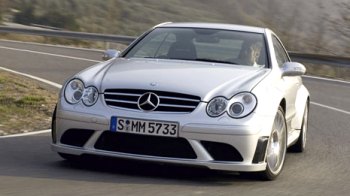 As everybody knows, Mercedes-Benz is a
luxury car maker instead of a sports car specialist. However, its AMG
division gets more and more ambitious in recent years. Having produced
at least one AMG model for each rear-drive Mercedes line, it started
introducing an even more hardcore line called the Black Series. The
Black series is much more expensive than the already expensive AMG
models. It is designed to be road and track cars appealing to the most
hardcore drivers, i.e., the same crowd as Porsche. The first product
was last year's SLK55 Black. Now it expands to CLK63 Black.
As everybody knows, Mercedes-Benz is a
luxury car maker instead of a sports car specialist. However, its AMG
division gets more and more ambitious in recent years. Having produced
at least one AMG model for each rear-drive Mercedes line, it started
introducing an even more hardcore line called the Black Series. The
Black series is much more expensive than the already expensive AMG
models. It is designed to be road and track cars appealing to the most
hardcore drivers, i.e., the same crowd as Porsche. The first product
was last year's SLK55 Black. Now it expands to CLK63 Black. 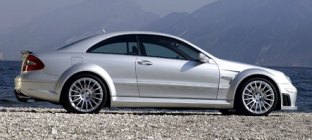 The
engine is still that 6208 cc AMG V8, but compare with the one used in
regular CLK63 it gets larger intake manifolds, smoother exhaust and
revised ECU to release another 26 horsepower from the top end. In other
words, it pumps out 507 horsepower at 6800 rpm. Maximum torque remains
unchanged at 465 lbft, but now arrives some 250 rpm higher than before,
at 5250 rpm. Transmission is again the 7-speed automatic with AMG's
Speedshift and paddle shift control. However, it offers only two modes
– Sport and Manual, with the Comfort mode deleted because this car is
obviously not designed for comfort. The final drive ratio is shortened
by 6 percent to sharpen acceleration. Predictably, CLK63 Black can eat
the likes of Audi RS4 and new BMW M3 for breakfast. Its 0-60 mph time
of 4.1 seconds is identical to 911 GT3, but slower than 911 Turbo. Top
speed is regulated to 186 mph. It could go faster, but unfortunately
not its tires.
The
engine is still that 6208 cc AMG V8, but compare with the one used in
regular CLK63 it gets larger intake manifolds, smoother exhaust and
revised ECU to release another 26 horsepower from the top end. In other
words, it pumps out 507 horsepower at 6800 rpm. Maximum torque remains
unchanged at 465 lbft, but now arrives some 250 rpm higher than before,
at 5250 rpm. Transmission is again the 7-speed automatic with AMG's
Speedshift and paddle shift control. However, it offers only two modes
– Sport and Manual, with the Comfort mode deleted because this car is
obviously not designed for comfort. The final drive ratio is shortened
by 6 percent to sharpen acceleration. Predictably, CLK63 Black can eat
the likes of Audi RS4 and new BMW M3 for breakfast. Its 0-60 mph time
of 4.1 seconds is identical to 911 GT3, but slower than 911 Turbo. Top
speed is regulated to 186 mph. It could go faster, but unfortunately
not its tires.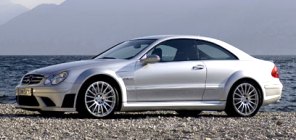 From
the CLK's appearance, it is hard to imagine it rivals Porsche 911
GT3 for performance and handling. Yes, those aggressive aero kits, vent holes, flared
wheel arches and big wheels imply its serious intention, but after all
it is still based on a coupe starting at £30,000 with a
four-cylinder engine. A GT3 beater ? Are you kidding ?
From
the CLK's appearance, it is hard to imagine it rivals Porsche 911
GT3 for performance and handling. Yes, those aggressive aero kits, vent holes, flared
wheel arches and big wheels imply its serious intention, but after all
it is still based on a coupe starting at £30,000 with a
four-cylinder engine. A GT3 beater ? Are you kidding ?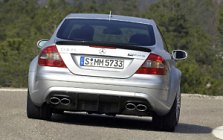 While
its power and speed is amazing, the real surprise is how accomplished
the chassis is. Traditional AMGs were high on power and weak in
chassis. Even the CLK63 cannot escape from such criticisms. In
contrast, CLK63 Black feels sharp and engaging immediately in the first
corner. Thanks to the radically reworked chassis and suspensions, it
provides rock-steady body control, massive grip and near neutral
cornering attitude. The meaty steering is confidence inspiring. The
strong yet linear power delivery and the presence of LSD means power
slide is easily accessible, at least on tracks. The huge brakes - 360mm
composite discs up front and 330 mm at the rear - do the job of slowing
down the car before bends effectively. Happily, on regular roads the
ride is not as harsh as its track car-look suggested, actually slightly
better than GT3.
While
its power and speed is amazing, the real surprise is how accomplished
the chassis is. Traditional AMGs were high on power and weak in
chassis. Even the CLK63 cannot escape from such criticisms. In
contrast, CLK63 Black feels sharp and engaging immediately in the first
corner. Thanks to the radically reworked chassis and suspensions, it
provides rock-steady body control, massive grip and near neutral
cornering attitude. The meaty steering is confidence inspiring. The
strong yet linear power delivery and the presence of LSD means power
slide is easily accessible, at least on tracks. The huge brakes - 360mm
composite discs up front and 330 mm at the rear - do the job of slowing
down the car before bends effectively. Happily, on regular roads the
ride is not as harsh as its track car-look suggested, actually slightly
better than GT3. 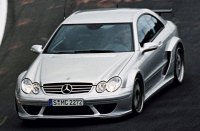 The
CLK DTM AMG road car is a limited edition built to celebrate its racing
version winning the German Touring Car Championship (DTM), Only 100
cars
will be built, making it far rarer than the company’s flagship
supercar,
SLR McLaren. Despite of its CLK root, the CLK DTM AMG is thoroughly
re-engineered
such that it is the fastest Mercedes-Benz next to the SLR.
The
CLK DTM AMG road car is a limited edition built to celebrate its racing
version winning the German Touring Car Championship (DTM), Only 100
cars
will be built, making it far rarer than the company’s flagship
supercar,
SLR McLaren. Despite of its CLK root, the CLK DTM AMG is thoroughly
re-engineered
such that it is the fastest Mercedes-Benz next to the SLR.
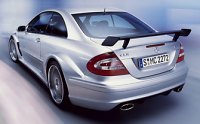 The
body of CLK DTM is heavily modified, with massive fenders made of
carbon-fiber
to stretch the tracks. The car sits lower than the standard CLK.
Suspensions
employ racing-style adjustable springs and gas-filled dampers. Inside,
everywhere in the cockpit is trimmed with carbon-fiber to save weight,
including the racing bucket seats. Rear seats are ditched in favour of
a cross brace to enhance body stiffness.
The
body of CLK DTM is heavily modified, with massive fenders made of
carbon-fiber
to stretch the tracks. The car sits lower than the standard CLK.
Suspensions
employ racing-style adjustable springs and gas-filled dampers. Inside,
everywhere in the cockpit is trimmed with carbon-fiber to save weight,
including the racing bucket seats. Rear seats are ditched in favour of
a cross brace to enhance body stiffness. 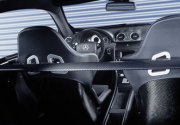 Those
people who had the opportunity to test it on the track found the car
extremely
quick, probably really quicker than SLR. Officially, it claims 3.9 sec
for 0-100kph (SLR: 3.8 sec), 0-200kph takes 10.9 sec (SLR needs 10.6
sec)
and a top speed electronically limited to 199 mph as this is the
maximum
speed of its tires. Can't believe it is based on a CLK !
Those
people who had the opportunity to test it on the track found the car
extremely
quick, probably really quicker than SLR. Officially, it claims 3.9 sec
for 0-100kph (SLR: 3.8 sec), 0-200kph takes 10.9 sec (SLR needs 10.6
sec)
and a top speed electronically limited to 199 mph as this is the
maximum
speed of its tires. Can't believe it is based on a CLK !